Chard, also known as Swiss chard or silver beet, is a pretty well-behaved and easygoing member of the vegetable garden.
It tends to mind its own business, content to grow colorful, tender, upright stalks of leafy, healthy goodness without much extra effort on your part.
If you are growing chard in your garden, you’ll want to pick the right companion plants to ensure yourself a healthy harvest.
You may simply want to maximize your growing space in a raised bed. If so, knowing which plants will thrive when grown side by side can be helpful.
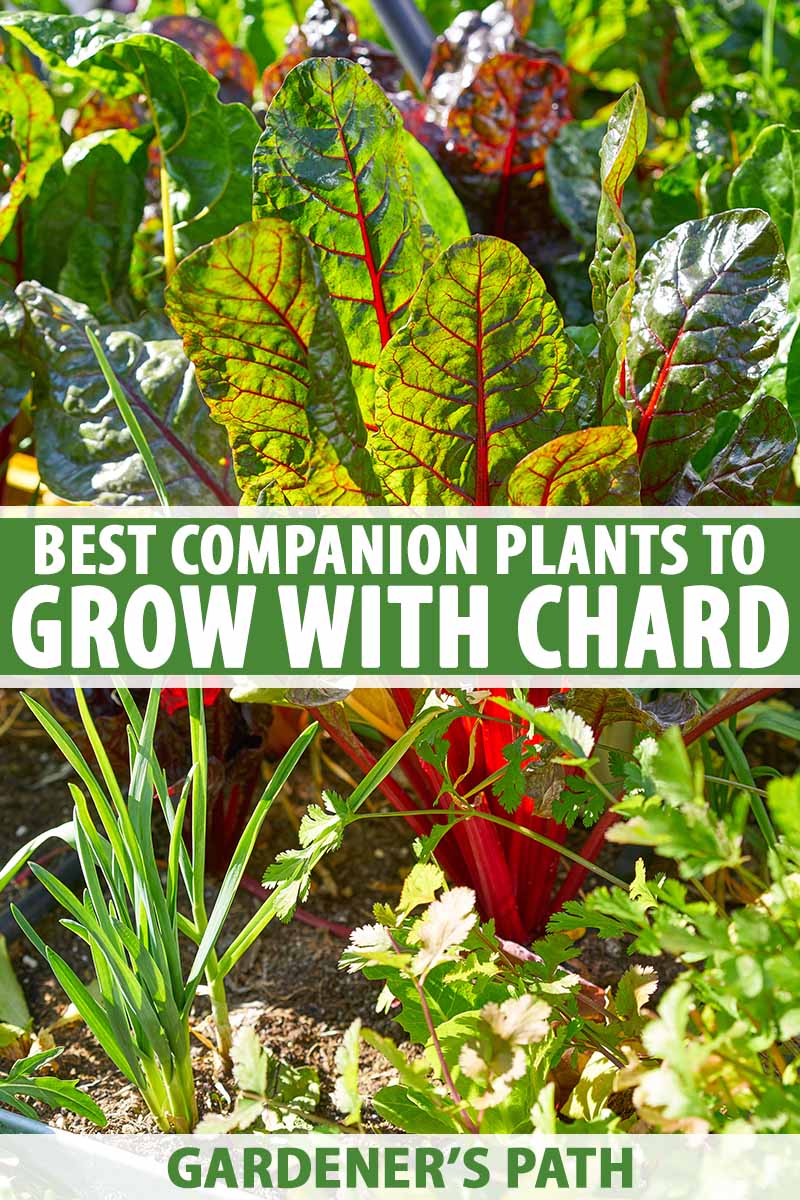
We link to vendors to help you find relevant products. If you buy from one of our links, we may earn a commission.
Or maybe you’re interested in upping your game when it comes to creating beneficial conditions for this leafy green – keeping garden pests away or providing beneficial nutrients to your soil.
You may also want to make sure to avoid plant neighbors that may have an adverse effect on your crop.
When deciding how to lay out your garden beds, you’ll want to be sure to select good neighbors, and avoid the bad ones.
In this article I’ll discuss seven of the best garden companions for Swiss chard, and let you know which to avoid.
Top Chard Companions
Swiss chard is a light feeder that is not particularly prone to pest or disease problems.
As such, it serves as a good companion for many types of plants – and there are many types of plants which could serve as good companions in return.

Though your available options may be numerous, why not start with seven of the top cited good neighbors for this leafy garden veggie?
This list is by no means exhaustive, but the companions described here all have either scientific evidence to support them, or their use has been valued and repeated by generations of gardeners and farmers.
1. Alliums
Alliums have at least two benefits as companion plants. With their strong odor, alliums such as garlic, shallots, onions, leeks, and chives can help to repel undesirable insects.
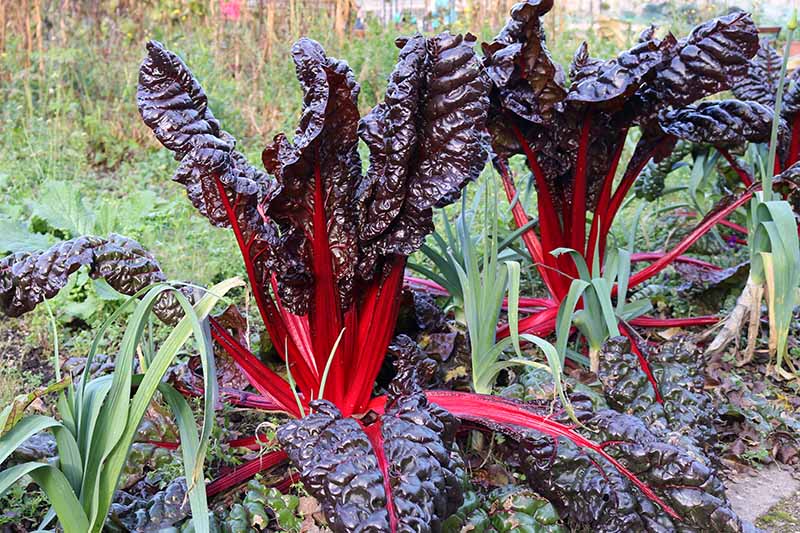
And when they bloom, they attract beneficial insects such as hoverflies, wasps, and bees.
Garlic chives are one of my favorite alliums. These have the beautiful globe-shaped flower heads of other alliums, are easy to harvest, and pack a strong punch of garlicky flavor.
And like other types of chives, they’re easy to grow from seed.
Another benefit of chives is that they bloom early and provide a source of food for beneficial predatory insects – the ones that can help to reduce pest populations.
Garlic chive seeds are available from Eden Brothers Nursery.
2. Annual Flowers
There are many types of annual flowers that would be excellent neighbors for Swiss chard.
Some varieties of chard are so colorful that they wouldn’t look at all out of place in a flower bed, and they can make an attractive border.
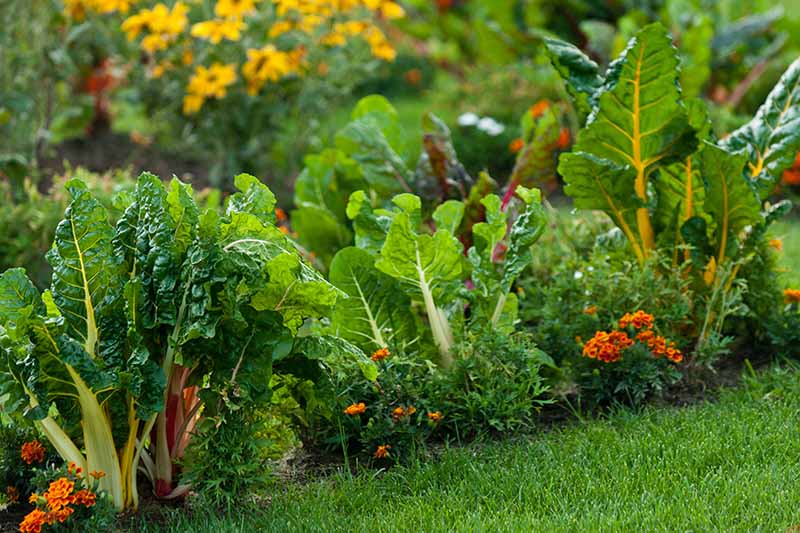
Marigolds make useful garden neighbors because of their ability to repel root-knot nematodes and other pests.
Nasturtiums also act as good garden friends, since their flowers attract beneficial insects and their strong-smelling leaves repel certain pests, such as aphids.
Sweet alyssum also makes a good companion, for multiple reasons.
It acts as a ground cover, helping to keep weeds at bay and shading the soil around your plants.
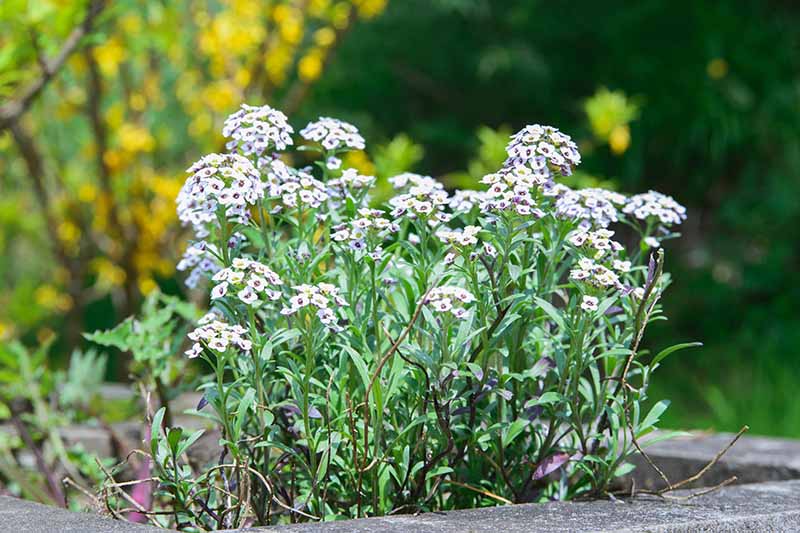
And sweet alyssum’s fragrant flowers attract beneficial insects such as hoverflies, which in turn keep aphid populations in check.
‘Carpet of Snow’ is a variety of sweet alyssum that makes a great ground cover. It grows to two to five inches tall, producing masses of small white flowers.
‘Carpet of Snow’ Sweet Alyssum
You can find ‘Carpet of Snow’ sweet alyssum seeds for purchase in a wide range of packet sizes at True Leaf Market.
3. Brassicas
Cabbage is widely cited in companion planting literature as a suitable buddy for chard.
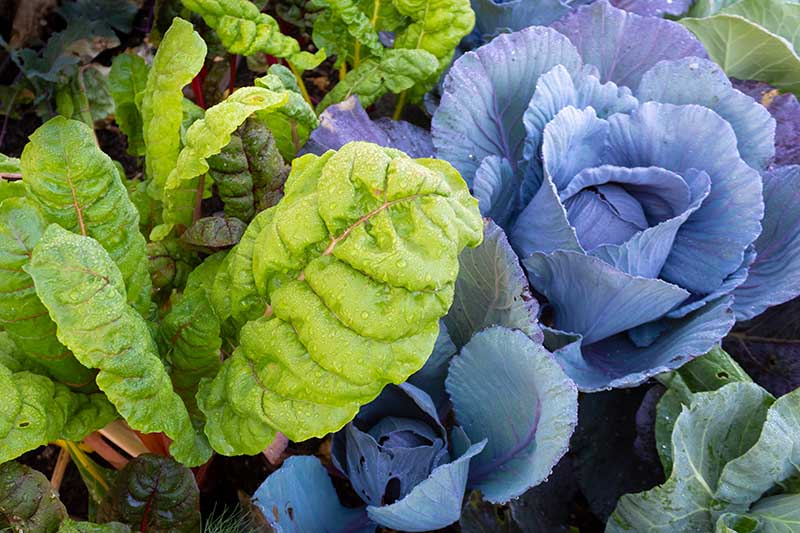
Other members of the cabbage family – such as broccoli, kohlrabi, kale, turnips, and radishes – make good neighbors too.
One potential benefit of cabbage is that it has a shallow root system, while chard roots go moderately deep.
Just like you don’t want the above ground portions of your plants fighting for space, you don’t want their underground portions fighting for room either.
Grouping plants with complementary root depths is one strategy in the art of companion planting.
My favorite type of cabbage is savoy. It has frilly, crinkly leaves and a milder, nuttier taste than smooth-leaved varieties.
‘Savoy Perfection’ has that wonderful mild and delicate savoy flavor. It will be ready to harvest in 90 days.
You can find ‘Savoy Perfection’ seeds in a variety of packet sizes available at True Leaf Market.
Learn more about how to grow savoy cabbage here.
4. Celery
Celery is another traditional silver beet companion. Celery is a compact plant that doesn’t get in chard’s way, either above ground or below – it also has a shallow root system.
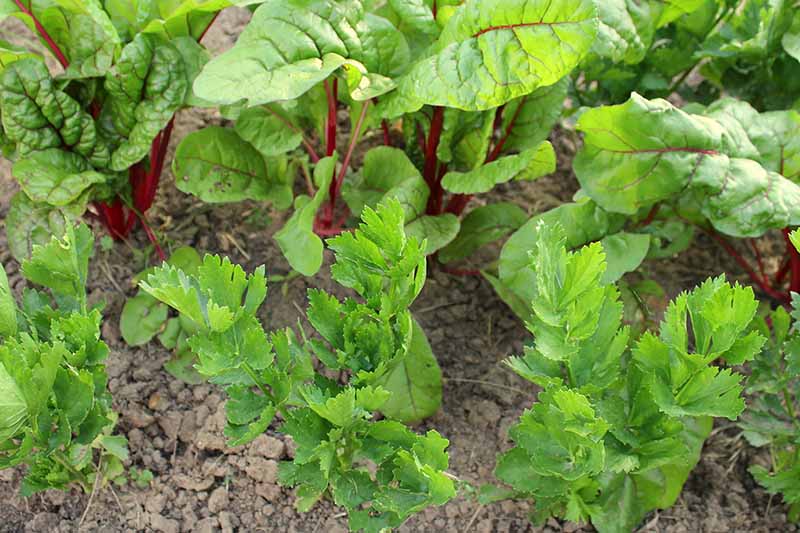
If you’re growing silver beet as a fall crop, you can grow celery right alongside it, and the cool weather of autumn will sweeten both of these plants.
Many gardeners buy celery as nursery starts to transplant into their gardens, but you can also grow celery from seed, opening up your options to a wider range of varieties.
‘Tall Utah’ is a cultivar with exceptionally long, crisp stalks. It takes about 120 days to reach maturity.
You can purchase ‘Tall Utah’ celery seeds in an assortment of package sizes at Eden Brothers.
Learn how to grow celery in this guide.
5. Herbs
According to companion planting lore, not all herbs make great neighbors for chard.
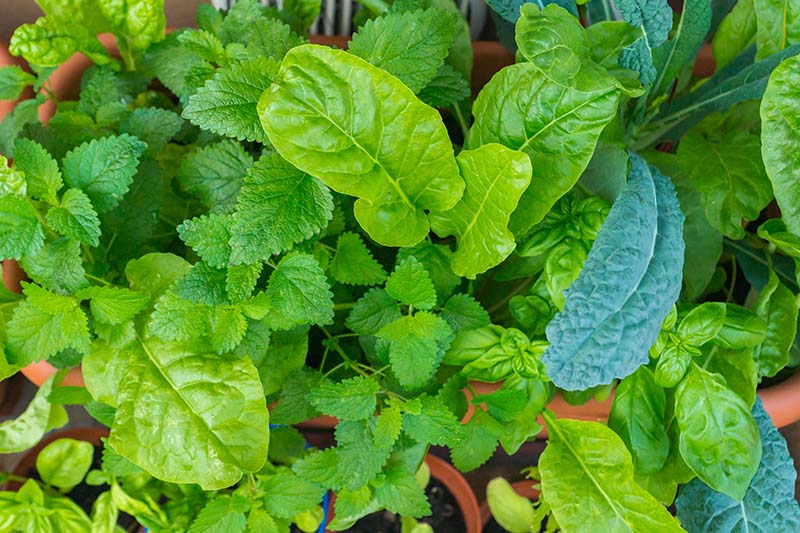
Personally, I haven’t noticed any problems growing this veggie with dill or cilantro – their benefits include being attractive to beneficial insects such as parasitic wasps and hoverflies.
Elaine Shallue at Sustainable Gardening Australia says that marjoram, lovage, and lavender are reported to be good neighbors for chard.
But among the herbs, mint has the best reputation of all.
If allowed to bloom, mint attracts beneficial insects with its masses of flowers. It also repels flea beetles, a common pest that can target your chard crop.
And the fragrant compounds in mint can mask the smells of other plants, making it harder for pests to locate their host plants.
However, if you decide to grow mint as a silver beet neighbor, keep it in a container so it doesn’t take over your whole vegetable patch.
While there are many different types of mint available, I prefer peppermint as my mint of choice because of its clean, fresh taste, and cooling properties.
It’s a wonderful herb to have around for making homemade iced herbal teas throughout the dog days of summer.
You can find peppermint seeds in a variety of packet sizes available at True Leaf Market.
Learn more about growing peppermint in your garden here.
6. Legumes
Legumes can help out your Swiss chard by fixing nitrogen in the soil. For this reason, bush beans and peas are typically considered good companions for this leafy green.
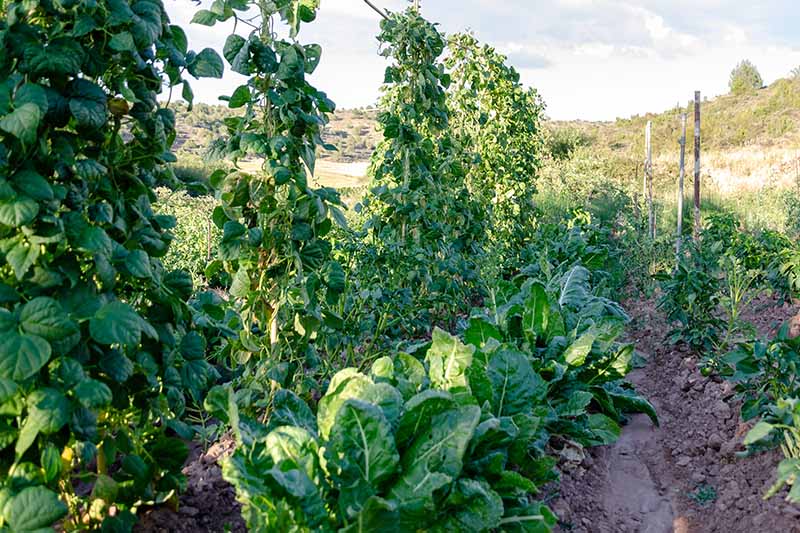
While bush beans and peas come with high recommendations, on the other hand, most companion planting literature advises against growing this veggie with pole beans.
Presumably, this is because of the towering nature of this crop when trellised. Peas are usually trellised too, but while peas die back in late spring or early summer, this is just when pole beans are taking off, and they may potentially shade out your silver beet crop.
However, if this is the sole reason to not include pole beans as a garden companion, there is certainly a workaround. If you plant your Swiss chard to the south of your pole bean trellis, it will still receive the full sun it prefers.
I think this is certainly a combo that needs more testing before we write it off.
Other legumes you might want to try out as garden buddies include fava beans and garbanzo beans.
In the meantime, feel free to stick with bush beans as your nitrogen fixing companion.
One of my favorite varieties of bush beans is ‘Cherokee Wax,’ a yellow snap bush bean.
And if you’re growing a colorful variety of silver beet, such as ‘Bright Lights,’ these two plants will provide your own personal off-Broadway show with their eye-catching colors. (Okay, maybe I don’t get out much these days…)

You’ll find ‘Cherokee Wax’ bush bean seeds in a variety of packet sizes available from Isla’s Garden Seeds via Amazon.
Learn how to plant and grow bush beans in this guide.
7. Lettuce
Lettuce is another good pairing for chard, according to traditional companion planting literature referenced by George Kuepper et al in an article published by the National Center for Appropriate Technology.
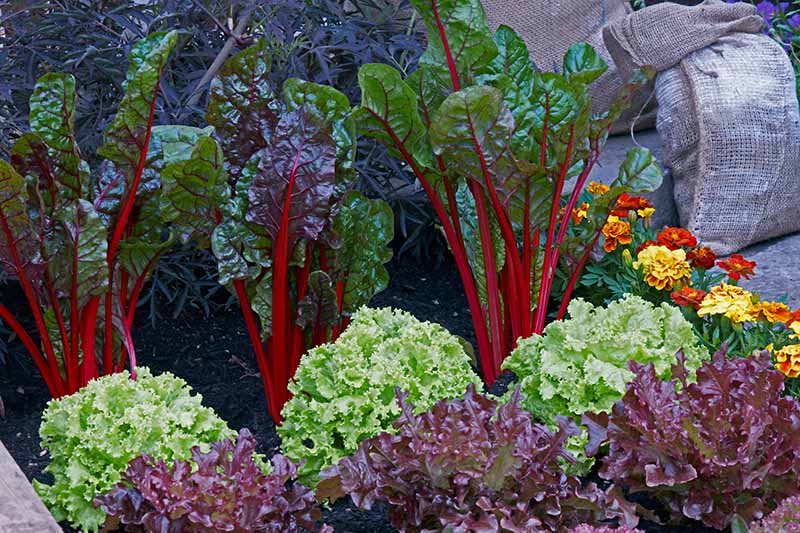
Growing these leafy veggies side by side will help maximize space in a square foot garden or in raised beds. And it will make your cut-and-come-again salad harvests easy.
Lettuce also has a shallow root system, so it won’t compete with your chard for underground space.
Another benefit to using lettuce as a garden buddy is that it can act as a living mulch, covering the soil to prevent weeds from popping up, and slowing erosion and water evaporation.
There are many varieties of lettuce that are both delicious and gorgeous. Some are better than others at providing the benefits of a living mulch – pick a lettuce variety that has a more spreading growth habit, such as Batavian, rather than one with an upright growth habit, such as Romaine.
‘Broadleaf Batavian’ is a type of escarole that has wide leaves that will spread out to cover the soil.
You’ll find ‘Broadleaf Batavian’ seeds in a variety of packet sizes available at Eden Brothers.
Learn how to plant and grow lettuce in this guide.
Bad Plant Neighbors
In addition to pole beans, there are some other plants you may want to avoid growing next to your chard crop.
Just like the juglone from black walnut trees, sunflowers can also be allelopathic, exuding chemicals from their roots, leaves, and stems that may be harmful to nearby plants.
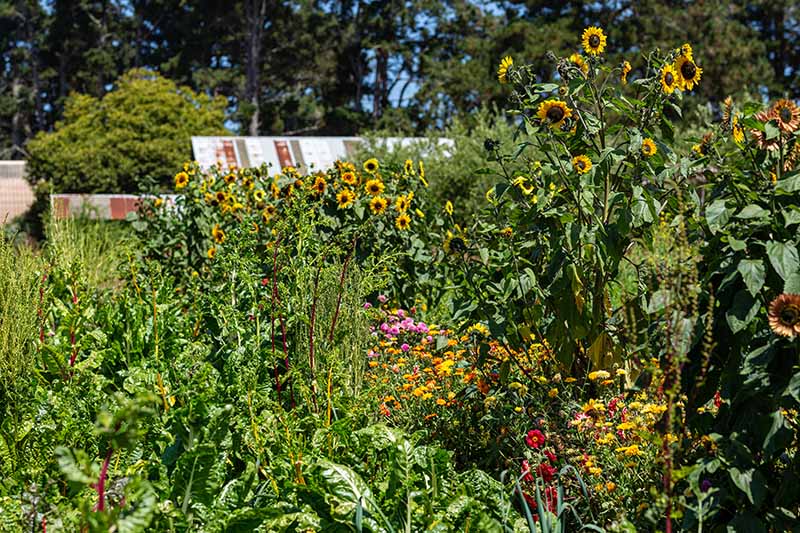
These chemicals inhibit seed germination and stunt growth in seedlings for many different types of plants, including but not limited to: grain sorghum, tomatoes, beans, corn, mustard, and some types of wheat and rice.
Taking advantage of the plant’s phytotoxic properties, sunflower leaf extracts have even been tested as natural herbicides against many weeds, including lamb’s quarter, another member of the amaranth family and a relative of Swiss chard.
Some growers successfully grow sunflowers in their gardens with no perceived ill effects, so this may be a combo you want to try before you totally rule it out.
You might also want to avoid growing this plant with other members of the goosefoot family, such as spinach, beets, amaranth, and quinoa.
This is recommended for pest and disease control, since all of these edible crops attract the same pests and are susceptible to the same pathogens.
If a pest has a penchant for one type of veggie, it typically enjoys closely related veggies as well.
Spreading out members of the same family can slow down pests, and prevent them from devouring the entire contents of your veggie beds. The spread of disease can be slowed in the same way.
However, to make crop rotations easier, you may still want to group members of the same family together, but create buffers between different plants with herbs, lettuce, alliums, or marigolds, to confuse and slow down pests.
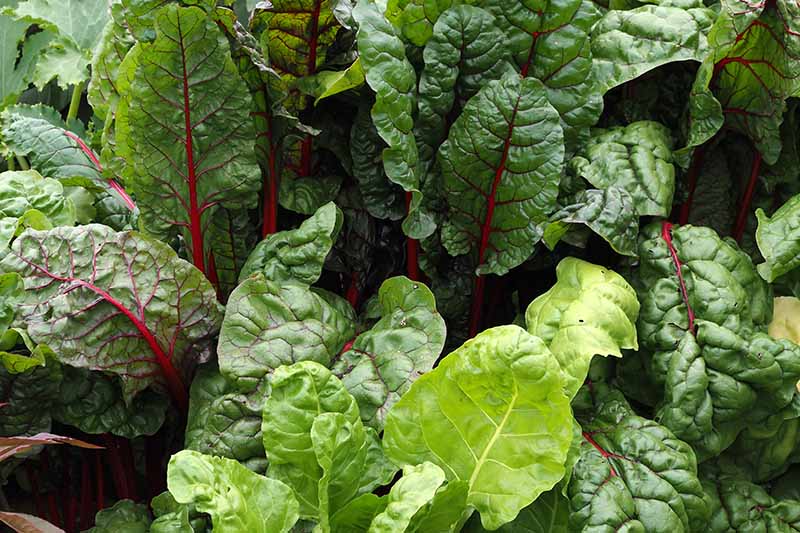
According to traditional literature, corn and potatoes do not make good neighbors for silver beet. Presumably this is because both of these crops are heavy feeders, and they will compete for nitrogen in the soil.
And all members of the cucurbit family – squash, melons, gourds, and cucumbers – also make bad neighbors for chard, according to tradition.
There seems to be at least one good reason behind this advice: the trailing vines of cucurbits could easily overwhelm, cover, and strangle your chard crop, since most of these crops are not traditionally trellised. They are also all heavy feeders.
Of course, if you are short on space and you really want to grow these vining crops as well as chard, vertical gardening is an option.
Be-leaf in Your Friends
Whether you’re interested in repelling pests, attracting beneficial insects, creating a living mulch, adding nitrogen to your soil, or steering clear of bad plant neighbors, you should now be set to choose from a selection of some of the top garden buddies for your Swiss chard.

Do you know any other tried and true companion plants for this leafy green? Which edible pairings have worked for you? Let us know your favorite growing combos for this garden veggie in the comments.
While you’re at it, how about learning more about how to grow some of the other goosefoot family members? Get started here:
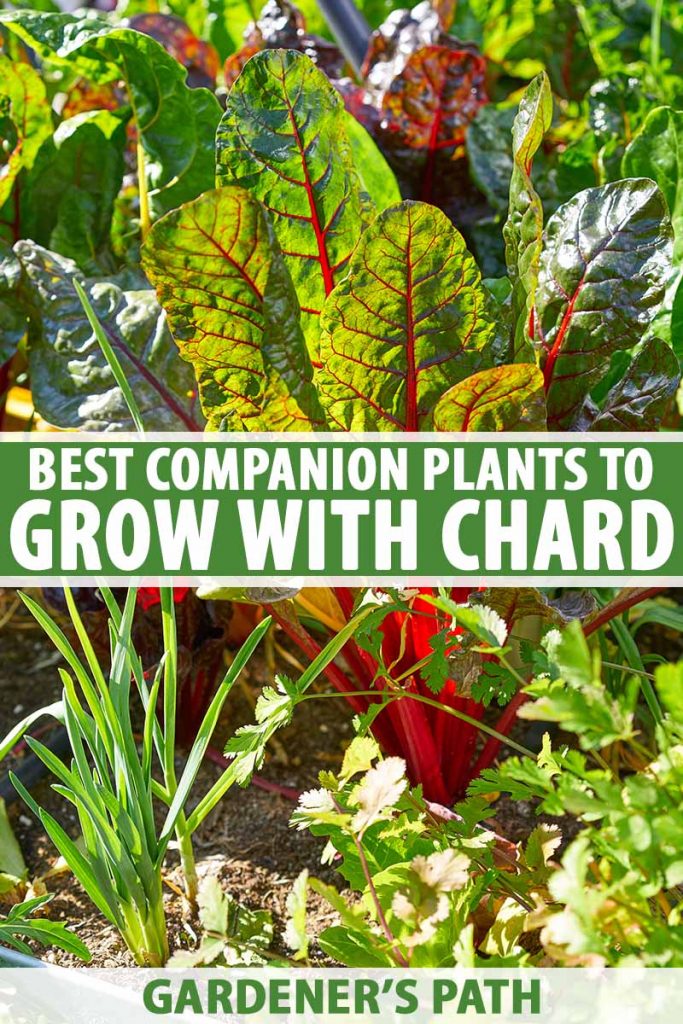
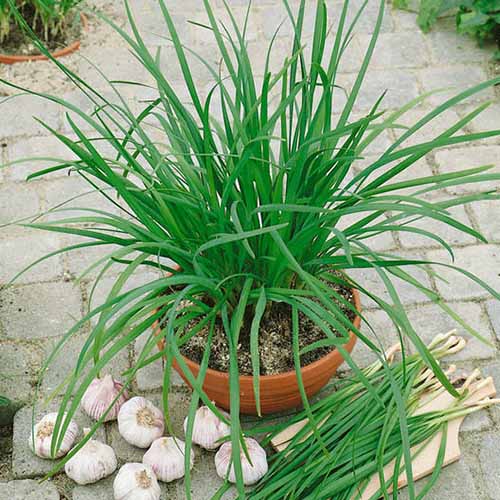
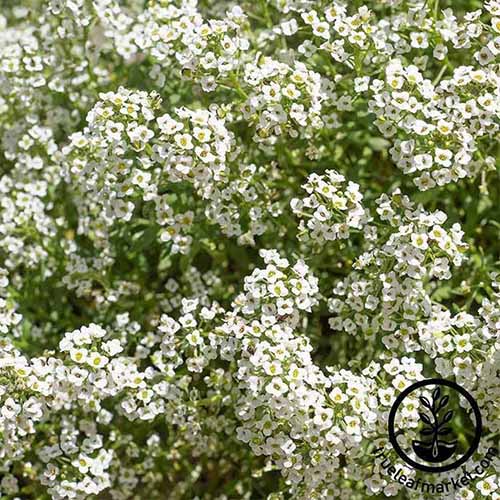
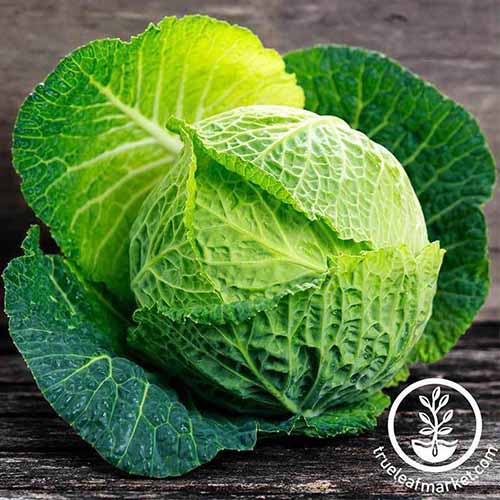
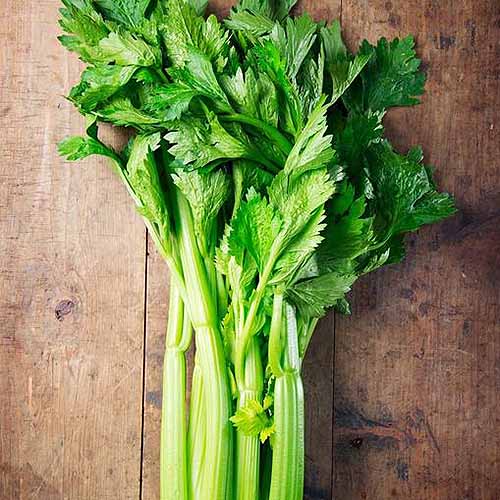
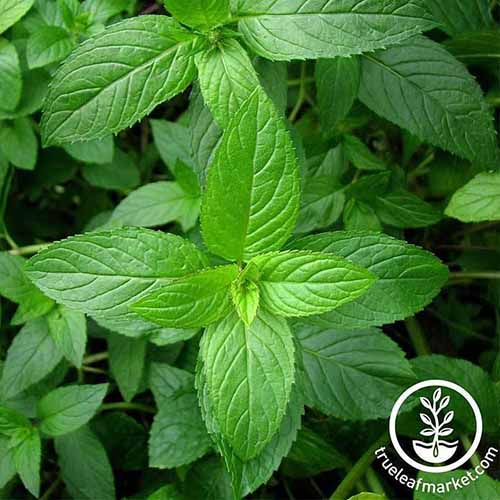
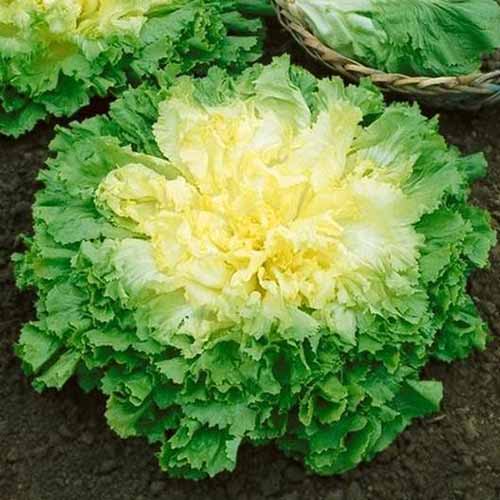
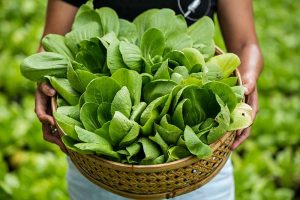
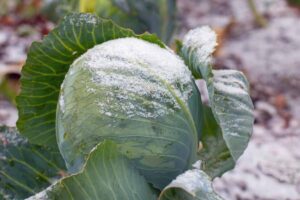
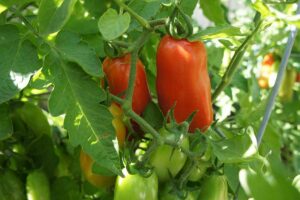
Awesome garden pics and facts!!
Hi Gordon! Thanks so much for taking time to leave a comment – and for the compliments!
Happy gardening!
Thank you, Ms. Hicks-Hamblin, for the trove of so many helpful tips. Pics are so vivid!
Hi there,
Thanks for taking time to leave a comment. I’m glad you found the article helpful. And isn’t chard such a photogenic garden veggie?
Happy New Year – and happy gardening!
Great tips! I always put some herbs like mint leaves beside my chard plant and I thought it was just a myth.
Thanks for sharing this amazing blog.
Enjoyed your chard info.
After my determinate tomatoes finish I’m planning on chard in two 20 gal cloth pots.
I have a question: Will the chard need full direct sun?
Hi Nina,
Chard will do well with full sun or part shade. Personally I like to plan mine so that they get full sun in spring and part shade in summer. If you need any more growing tips, you’ll find lots of info in our complete guide to growing chard.
Hope this helps!